The Complete Carpenter: Christine (1983)
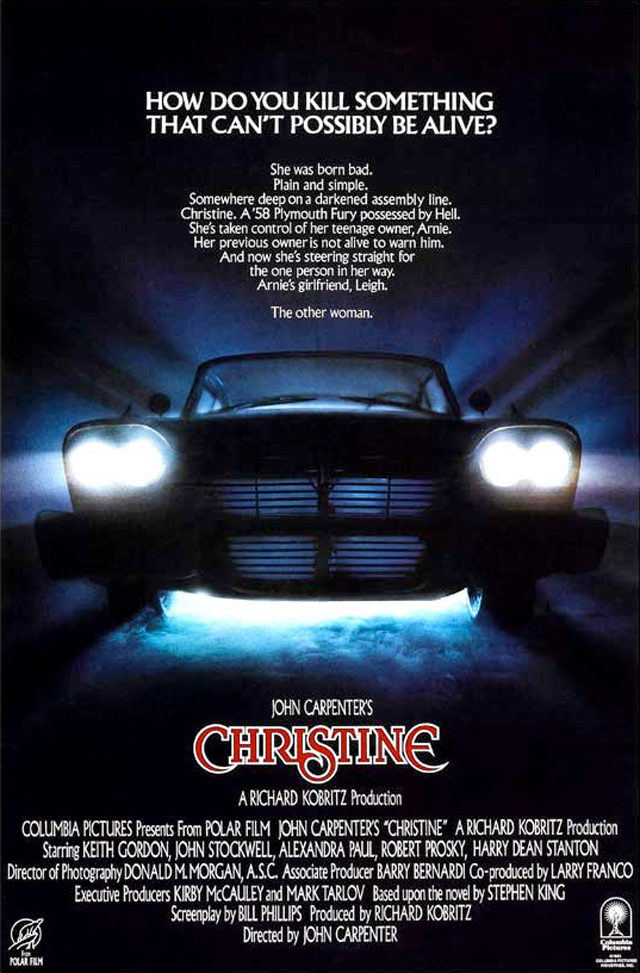 It’s a Stephen King September, thanks to the monstrous success last week of It: highest grossing September opening ever, highest grossing horror movie opening ever, and only a Deadpool away from highest grossing R-rated opening ever. (Our own Sue Granquist’s take.) A perfect time to fast-track the next movie in my John Carpenter career retrospective, also a Stephen King adaptation.
It’s a Stephen King September, thanks to the monstrous success last week of It: highest grossing September opening ever, highest grossing horror movie opening ever, and only a Deadpool away from highest grossing R-rated opening ever. (Our own Sue Granquist’s take.) A perfect time to fast-track the next movie in my John Carpenter career retrospective, also a Stephen King adaptation.
And in some unfortunate tragic timing, Harry Dean Stanton died the day before I posted this. Stanton was one of the great character actors of the last sixty years, a continual presence in movies from the moment I first started watching them, and appeared memorably in two John Carpenter films, Escape from New York and today’s subject, Christine. Stanton lived a long, full life (he was 91) but will still be immensely missed. Few people could steal a scene like he could.
*Sniffle* Anyway, back to our regular program.
In the wake of the financial failure of The Thing, John Carpenter needed a studio project to keep busy, and took up producer Richard Kobritz’s offer to direct Christine, based on a Stephen King novel that was still in galleys. (The book was published in April and the movie premiered in December.) Carpenter originally intended to direct another King adaptation, Firestarter, which Universal offered to him. But after the box-office crash of The Thing, Universal cut the budget for Firestarter in half, and Carpenter opted out. When he ended up at Columbia with Christine, the screenwriter of the early drafts of Firestarter, Bill Phillips, went with him to handle the scripting chores.
The film was a mild success, grossing twice its $10 million budget. Like most of Carpenter’s movies from this period, Christine has maintained a steady profile ever since. Along with Carrie, The Shining, and The Dead Zone, it’s part of a group of early Stephen King movies from major directors.
The Story
Arnie Cunningham (Keith Gordon) is an awkward, nerdy high schooler in 1978 who deals with vicious bullying. Then he makes an impulse purchase of a broken-down 1958 Plymouth Fury nicknamed “Christine.” Arnie makes rebuilding Christine into a project, then an obsession. As Christine is restored to her original red gleaming glory, Arnie transforms into a handsome, arrogant hotshot who starts dating the school’s new super-cutie, Leigh Cabot (Alexandra Paul).
But there’s more to Christine than her shiny red paint job and gleaming fins. The car was apparently “born bad” with a possessive malevolence, and it sinks its hooks deep into Arnie. When Arnie’s high school tormentors break into the garage and trash Christine, the car miraculously reconstructs itself and goes on a rampage, running down the defacers and anyone who might get between Christine and Arnie’s love. The deaths attract the attention of a police detective (Harry Dean Stanton, RIP). Eventually, Leigh and Arnie’s best friend Dennis Guilder (John Stockwell) work together to attempt to free Arnie from Christine’s grip and destroy the car for good.
The Positives
Christine was the first time John Carpenter took on directing work that wasn’t personal for him. Despite his dismissive attitude toward the film as “just a job,” Christine is a solid early ‘80s horror movie that deserves its loyal following. It’s definitely in the upper half of Stephen King adaptations. At this point in his career, Carpenter was incapable of really phoning it in, and even giving a lesser effort still produces a worthwhile movie that for most other directors would be the top entry in their careers. Christine is fun popcorn horror with a good sense of its two protagonists, Arnie and the car, and terrific work from its character actors.
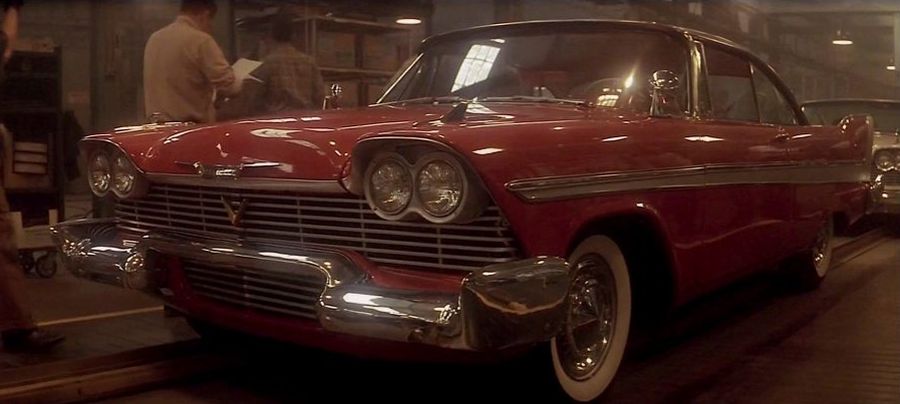 Stephen King novels are massive, even the ostensibly “shorter” ones like Christine; this puts his material at odds with Carpenter’s style. The men share many interests: horror, rock music, Boomer nostalgia, B-movie monsters. But King is an author of heaps of detail, while Carpenter is a filmmaker of intense efficiency, as streamlined as Christine’s profile. So it’s surprising how well the stripped-down 110-minute Carpenter version of a 526-page dense King novel works. Bill Phillips’s screenplay boils down the story to its essentials without making it feel as if much has been cut (with one exception I’ll get to later). The smartest move was to remove the extra step in Christine’s supernatural nature. In the book, the Plymouth Fury is possessed by a previous owner, who starts to take over Arnie as well. In the movie, Christine rolls off the Detroit assembly line already a thing of evil. The purity of Christine as a devilish entity is one of the film’s best assets, and strengthens the theme of American culture’s deification of the automobile.
Stephen King novels are massive, even the ostensibly “shorter” ones like Christine; this puts his material at odds with Carpenter’s style. The men share many interests: horror, rock music, Boomer nostalgia, B-movie monsters. But King is an author of heaps of detail, while Carpenter is a filmmaker of intense efficiency, as streamlined as Christine’s profile. So it’s surprising how well the stripped-down 110-minute Carpenter version of a 526-page dense King novel works. Bill Phillips’s screenplay boils down the story to its essentials without making it feel as if much has been cut (with one exception I’ll get to later). The smartest move was to remove the extra step in Christine’s supernatural nature. In the book, the Plymouth Fury is possessed by a previous owner, who starts to take over Arnie as well. In the movie, Christine rolls off the Detroit assembly line already a thing of evil. The purity of Christine as a devilish entity is one of the film’s best assets, and strengthens the theme of American culture’s deification of the automobile.
Christine’s cinematic soulmate is Carrie (1976), another Stephen King adaptation from a Young Turk filmmaker: both are about an outsider trapped in a high school hell who supernaturally turns the tables on bullies in a grisly way before a tragic end. There’s also an overbearing mother figure, although Christine Belford as Regina Cunningham is a few levels down in intensity from Piper Laurie’s Margaret White.
However, Christine is more than a 1:1 gender flip of Carrie. The thrill of watching high school villains receive a violent comeuppance is there, but Christine also explores the idea of 1950s masculinity, worship of the car as feminine, and Baby Boomer nostalgia, all of which emerge as destructive forces. The last line of the film, spoken by a 1978 teen to the crushed square of 1958 car, “God, I hate rock-and-roll,” is a rejection of that entire package. This isn’t a sentiment rock-loving John Carpenter and Stephen King share personally, but credit to Carpenter for how repulsive he makes the ‘50s tough guy appear in the transformation of Arnie Cunningham under the influence of an automotive femme fatale. “God, I hate rock-and-roll.” Yeah, I don’t agree … but for that moment, I get it.
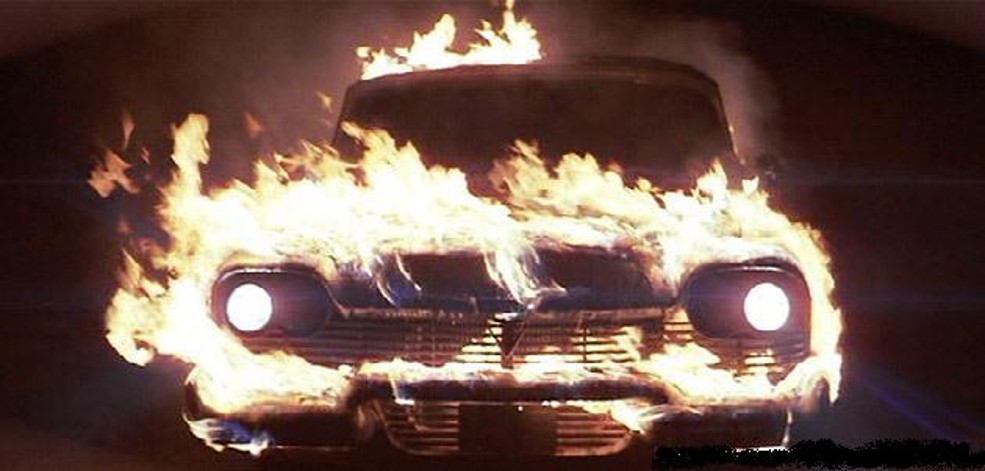 Keith Gordon does one of the most remarkable ugly duckling-to-black swan transformations in movies. With this type of character rebirth — whether it’s a Pygmalion or a Nutty Professor — there’s always the risk the actor won’t convincingly execute one side of the character, or audiences won’t buy the “uglification” of an attractive performer. But Gordon is dead-on as both Nerd Arnie and Evil Arnie, only hampered by the speed the movie switches from one to the other. Gordon doesn’t show off the catalog-model handsomeness of John Stockwell, but his Evil Arnie carries himself with such a coolness and swagger with an undercurrent of violent, misogynist sexuality that he visually overwhelms the other performers. His version of handsome is a 1950s throwback befitting Christine’s origin, and Gordon digs deep into it. Just the way he alters his voice inflection and holds his lips under Christine’s grip is powerful.
Keith Gordon does one of the most remarkable ugly duckling-to-black swan transformations in movies. With this type of character rebirth — whether it’s a Pygmalion or a Nutty Professor — there’s always the risk the actor won’t convincingly execute one side of the character, or audiences won’t buy the “uglification” of an attractive performer. But Gordon is dead-on as both Nerd Arnie and Evil Arnie, only hampered by the speed the movie switches from one to the other. Gordon doesn’t show off the catalog-model handsomeness of John Stockwell, but his Evil Arnie carries himself with such a coolness and swagger with an undercurrent of violent, misogynist sexuality that he visually overwhelms the other performers. His version of handsome is a 1950s throwback befitting Christine’s origin, and Gordon digs deep into it. Just the way he alters his voice inflection and holds his lips under Christine’s grip is powerful.
The John Carpenter Acting Company is primarily absent, but there are three stellar turns from older character actors to go along with Keith Gordon’s performance. Harry Dean Stanton is the only returnee from a previous Carpenter film, which is unfortunate since it’s easy to imagine the actor fitting into plenty of other Carpenter projects. He’s an ideal fit for Stephen King’s world as well. An even better match for Carpenter and King is Robert Prosky as Darnell, the surly garage owner. A grotesque hulk with a growling sandpaper voice and a perpetual wad of chew in his cheek, Darnell is the picture of the working class monster Stephen King often peppered his books with, and Prosky nails it. Finally, Roberts Blossom, best known to audiences as Old Man Marley from Home Alone, makes a creepy impression as George LeBay, the rotting skeleton of a man with an evil gleam in his eyes who sells Christine to Arnie. In his two scenes, Blossoms conveys what addiction to Christine means and establishes Arnie’s coming break with Dennis. I have no idea why Blossom didn’t have a role in They Live.
A new cinematographer, Donald M. Morgan, replaces Dean Cundey. Morgan had worked with Carpenter on the television movie Elvis and would also shoot his next film, Starman, before Cundey returned once more for Big Trouble in Little China. Although Morgan doesn’t have the absolute mastery of composition Cundey has, Christine still looks superb. The camera fetishizes its title subject with the widescreen lens; sleek 1950s cars were made to fill up the frame of a Panavision camera. The attack scenes at night make wonderful use of inky darkness and lens flares from the headlights slashing from one side of the frame to the other.
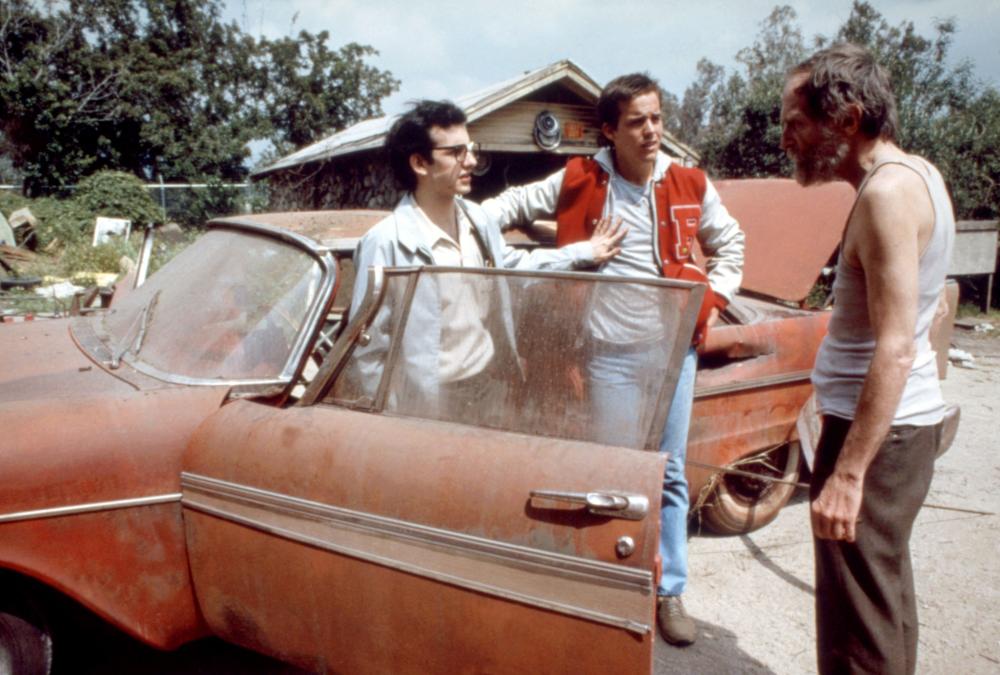 Christine has one of the best blended musical soundtracks of the decade, weaving an original score with pop songs that serve as dramatic devices rather than gimmicks to sell an album. Christine’s radio only plays 1950s rock and pop, which becomes her voice, a sort of stalker’s mixtape. She taunts Dennis trying to open her doors with Little Richard’s cover of “Keep A-Knockin’”; crushes Darnell while singing about “Bony Maronie” (“She’s as skinny as a stick of Macaroni”); romantically croons to Arnie how she’s “Pledging My Love”; and defiantly chants “Rock and Roll Is Here to Stay” as she tries to regenerate under the treads of a bulldozer. Most powerful is Christine’s anthem of possession, “We Belong Together” by Robert & Johnny, played as she tries to choke Leigh to death: “You’re mine, you belong to me … you belong to only me … from now until eternity.” The songs also create a neat jump from the prologue in 1957 to the main action in 1978 by switching from Buddy Holly’s “Not Fade Away” to Tanya Tucker’s country-rock cover version. The original electronic score from Carpenter and Alan Howarth is slow and somber, painting Arnie’s obsession, until it kicks into the one the most rockin’ pieces of the Carpenter/Howarth canon, “Christine Attacks (Plymouth Fury).” It’s an underrated soundtrack in the Carpenter music library. (Carpenter this week released a Christine music video to promote his upcoming Anthology album. Fun, but I’m not fond of the new arrangement. Needs more Howarth.)
Christine has one of the best blended musical soundtracks of the decade, weaving an original score with pop songs that serve as dramatic devices rather than gimmicks to sell an album. Christine’s radio only plays 1950s rock and pop, which becomes her voice, a sort of stalker’s mixtape. She taunts Dennis trying to open her doors with Little Richard’s cover of “Keep A-Knockin’”; crushes Darnell while singing about “Bony Maronie” (“She’s as skinny as a stick of Macaroni”); romantically croons to Arnie how she’s “Pledging My Love”; and defiantly chants “Rock and Roll Is Here to Stay” as she tries to regenerate under the treads of a bulldozer. Most powerful is Christine’s anthem of possession, “We Belong Together” by Robert & Johnny, played as she tries to choke Leigh to death: “You’re mine, you belong to me … you belong to only me … from now until eternity.” The songs also create a neat jump from the prologue in 1957 to the main action in 1978 by switching from Buddy Holly’s “Not Fade Away” to Tanya Tucker’s country-rock cover version. The original electronic score from Carpenter and Alan Howarth is slow and somber, painting Arnie’s obsession, until it kicks into the one the most rockin’ pieces of the Carpenter/Howarth canon, “Christine Attacks (Plymouth Fury).” It’s an underrated soundtrack in the Carpenter music library. (Carpenter this week released a Christine music video to promote his upcoming Anthology album. Fun, but I’m not fond of the new arrangement. Needs more Howarth.)
Although the special effects magic of The Thing is impossible to best, Christine does feature an excellent VFX “wow” moment when the car rebuilds itself after the bullies total it. As Arnie watches in satisfaction at the carnage to come, Christine reforms to pristine shape through hydraulic mechanical effects shown in reverse. It’s far better than any CGI version of the scene could be.
Firestarter ended up being made at Warner Bros. the next year with Mark L. Lester in the director’s chair. Christine is a much, much better movie. Just thought I’d point that out.
The Negatives
First, let’s admit that after The Thing, almost any movie was going to feel like a letdown. Expecting three masterpieces in a row from any director is too optimistic.
Although superior to later films where Carpenter was emotionally detached from the direction (Memoirs of an Invisible Man, Village of the Damned), Christine is the first movie of his career that feels a touch … ordinary. The visual flair and directorial competence are there, but a vitality and special weirdness are missing. We have a final product that Lewis Teague — director of Cujo, the other Stephen King movie of 1983 — could have directed at the same level. Christine is a good film, which is just shy of being a compliment when it comes to John Carpenter in the 1980s.
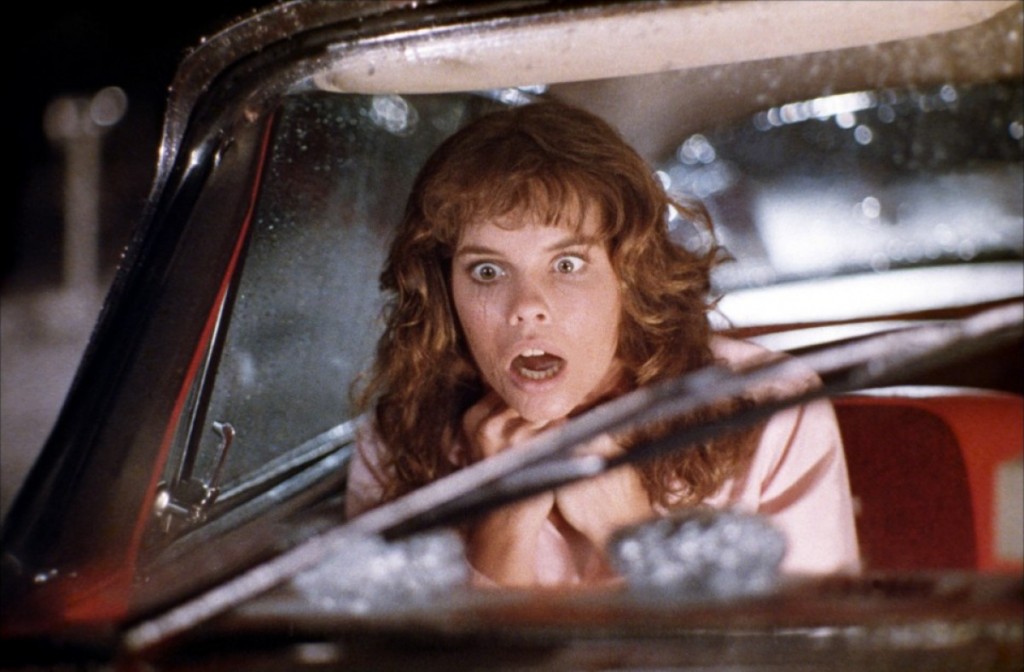 Carpenter’s original reaction to reading the novel Christine was that he didn’t think it was scary. The feeling carried over to the finished film, because Christine is, well, just not that scary. The tension mastery of Carpenter’s previous work isn’t apparent here, although there are moody visual set-pieces, such as a flame-engulfed Christine roaring down on Buddy (who for some reason tries to escape a car by running down the middle of a road). It’s an extravagant piece of craftsmanship — but the execution isn’t terribly suspenseful, which is a surprise considering we’re talking about the director of Halloween and The Thing.
Carpenter’s original reaction to reading the novel Christine was that he didn’t think it was scary. The feeling carried over to the finished film, because Christine is, well, just not that scary. The tension mastery of Carpenter’s previous work isn’t apparent here, although there are moody visual set-pieces, such as a flame-engulfed Christine roaring down on Buddy (who for some reason tries to escape a car by running down the middle of a road). It’s an extravagant piece of craftsmanship — but the execution isn’t terribly suspenseful, which is a surprise considering we’re talking about the director of Halloween and The Thing.
The place where the reduction of King’s novel feels apparent even to people who haven’t read it is the speed of Nerd Arnie’s transformation into Evil Arnie. It happens abruptly, making it seem as if an important sequence went missing. Keith Gordon hits all his marks, but there are a few steps of the process Arnie goes through as Christine takes him over that he never gets to work with.
Similar to the way Alfred Hitchcock handled Vera Miles and John Gavin in Psycho, Carpenter doesn’t display much interest in the nominal hero and heroine, John Stockwell as Dennis and Alexandra Paul as Leigh. They are the “pretty people” of the story, and not given much attention. (Both Stockwell and Paul started their careers as fashion models.) When the movie finally has to lean heavily on Leigh and Dennis as the finale warms up, it’s clear Carpenter doesn’t care much about either. Stockwell is more interesting in the first part, before a football injury removes him from the middle stretch. He churns up good chemistry with Keith Gordon in a fraught confrontation with Arnie during a night drive. But when he’s away from Gordon, Stockwell seems a touch lost in the hero role.
Alexandra Paul fares worse. Leigh comes across more as an attractive prop than a character. Her falling for Arnie never makes much sense, nor do we ever see what it is Leigh likes about Evil Arnie. He doesn’t seem like her type at all. (She isn’t impressed with his car, we know that.) Their initial courtship happens off-screen, probably because it’s tough to imagine Leigh saying “yes” to this obvious sleaze, or that she would care about him later after his repeated verbal abuse. This weakness in Leigh ends up harming Christine, whose jealousy and hatred of the Other Woman is supposed to be a key motivator (Leigh is the bait luring Christine to her destruction in the garage showdown). Credit to Alexandra Paul for her convincing choking scene, however, probably the film’s tensest moment.
The Pessimistic Carpenter Ending
Arnie dies during Christine’s final duel with Dennis and Leigh, never escaping the car’s control. Christine croons over his body with her radio before Dennis’s bulldozer crushes her. The compacted remains are dumped into a junkyard and it’s all over — or is it?
Next: Starman
Harry Dean Stanton 1926–2017
Ryan Harvey is one of the original bloggers for Black Gate, starting in 2008. He received the Writers of the Future Award for his short story “An Acolyte of Black Spires,” and his stories “The Sorrowless Thief” and “Stand at Dubun-Geb” are available in Black Gate online fiction. A further Ahn-Tarqa adventure, “Farewell to Tyrn”, is currently available as an e-book. Ryan lives in Costa Mesa, California where he works as a professional writer for a marketing company. Occasionally, people ask him to talk about Edgar Rice Burroughs or Godzilla in interviews.
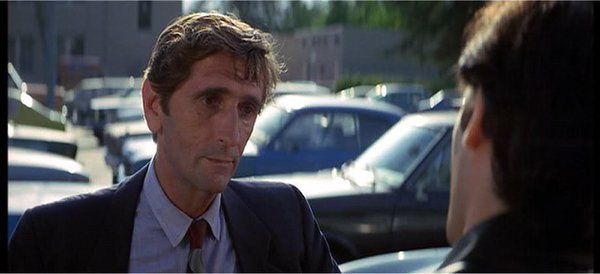
Great, spot-on review. I agree. This is one of the better, yet underrated Carpenter movies, and one of the best King adaptations.
I remember the TV commercial for this movie went something like “Body by Plymouth. Soul by Satan.” Cracks me up now!
Coincidentally, I watched Christine for the first time last week. I thoroughly enjoyed it. I really liked how, rather than use a creepy backstory to “explain” the car’s malevolence, the movie shows that Christine was, inexplicably, just born bad. The visual beauty of the opening and the sheer irrationality of this basic fact make the horror all that more convincing to me. It’s almost like a car version of The Haunting (1963), which is about a house that is itself evil rather than haunted by evil spirits.
Raphael’s “born bad” comment just made me remember another positive about this movie: the George Thorogood song, “Bad to the Bone.” That song is a great addition to the movie!
Christine is pretty much the reason “Bad to the Bone” become well known. It wasn’t a hit on its initial release in 1982, and Christine boosted its profile so that within a few years it was a go-to song for every other movie trailer, and of course was used prominently in Terminator 2.
@Harvey
Yeah, I remember that. The song did indeed pre-date the movie but after it, the song pretty much became synonymous with Christine until Terminator 2. Anyways, great song, and fits very well with Christine, and I think more so than Terminator 2.
And I STILL want a 1958 Plymouth Fury; but I’d name him “George”…
-GC